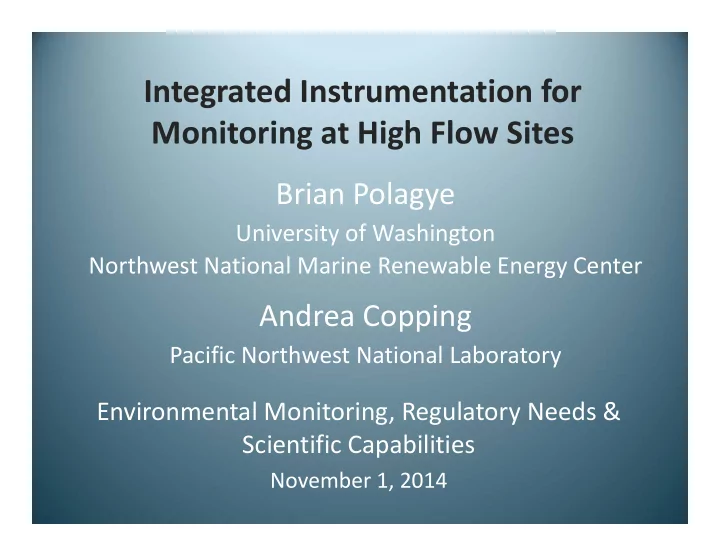

Integrated Instrumentation for Monitoring at High Flow Sites Brian Polagye University of Washington Northwest National Marine Renewable Energy Center Andrea Copping Pacific Northwest National Laboratory Environmental Monitoring, Regulatory Needs & Scientific Capabilities November 1, 2014
Motivation Environmental studies at pilot projects: — Expensive in relation to overall project costs — Have shown that small projects are unlikely to have biologically significant environmental impacts. Extrapolation to larger commercial projects is difficult — Limited acceptance of results to reduce uncertainty for large commercial scale developments. Paradox for Commercial scale MRE development Environmental Environmental harm from but monitoring costs are early commercial projects crippling to industry could cripple the industry
Early ‐ stage Emphasis “Nearfield” Direct interaction of marine mammals, fish, sea turtles, and birds with MECs (collision, abrasion, strike) Distribution Changes in the distribution and use of habitats by marine animals in very high energy areas Sound Characteristics of the sound produced by marine energy converters
Instrumentation: Active Acoustics Deployment and survival at high flow sites is challenging Direct interactions with a MEC is not currently observable with most active acoustic Sound Metrics ARIS (imaging) technologies Data processing and automation needs development ― High data intensity requires automated pre ‐ or post ‐ processing ― Not available for several types of BioSonics DTX (split ‐ beam) active acoustic instruments (e.g., Autonomous Deployment acoustic cameras)
Instrumentation: Passive Acoustics Hydrophones work well, but OceanSonics room for improvement icListen HF exists in high energy environments ― Flow noise problematic for moored instrumentation at JASCO AMAR (recorder) current energy sites Data processing and automation needs development ― High data intensity, but only a small push to real ‐ time processing (compared to active acoustics) Chelonia C ‐ POD (click detector)
Instrumentation: Optical Joslin, J. S. Parker ‐ Stetter, and B. Polagye (2014), Development of a stereo ‐ optical camera system for monitoring tidal turbines, SPIE J. of Applied Remote Sensing.
Objective: Reduce Risk Uncertainty Significant Uncertain Risk Discountable Risks Mitigate Risk Monitor Strategic Research Investment Identified Risks “Retired” Risks Residual Uncertainty
How to Achieve This? Severe outcomes are likely to rarely occur Observing interactions may require spatially comprehensive and temporally continuous monitoring Strategy likely to generate “data mortgages” Stereo ‐ optical 3 months 600 TB of X = Cameras (2 Mpx X 80 MB/s observations storage @ 10 fps) Example : Continuous stereo ‐ optical monitoring for a single camera pair. Comprehensive monitoring would require multiple pairs.
Integrated Instrumentation Packages Low ‐ cost and near ‐ term approaches to improve ratio of information gained to data archived Multi ‐ beam Sonar Passive Acoustic Tracking capability at Detection ranges out to 100 m Omni ‐ directional Processing in near coverage at ranges on real ‐ time the order of 1 km Processing in near MEC real ‐ time Optical Camera Short range and Example : Detection, tracking, and identification of a marine limited field of view mammal approaching a MEC Requires archival processing
Constraints for Integrated Packages Data and Power Cabled MEC Export Package Bandwidth Cable Close Coupling and to MEC “Plug & Maintainable Recoverable Socket” and Adaptable Package Approach
Adaptable Monitoring Package (AMP) “Plug” AMP “Socket” Seafloor Mounted Docking Station
AMP Infrastructure and Instrumentation Power and data infrastructure Securement and recovery system Instruments
Recovery/Deployment Options Converter Divers Recovery Short work windows Can be expensive and risky Human safety risk Subsea ROV Winch Servicing Moving parts in the ocean Short work windows Winch failure can cause catastrophic system failure
AMP Deployment Concept Current Direction
Design for High Flow Operations Initial “Millennium” Falcon Normalized velocity around the tank test (August) “Millennium” Falcon and AMP during deployments
Summary Integrated instrumentation packages will play a critical role in reducing environmental risk without incurring large data mortgages Package design requires a significant systems engineering effort
Acknowledgements This material is based upon work supported by the Department of Energy under FG36 ‐ 08GO18179 ‐ M001 and Snohomish Public Utility District. The AMP represents the engineering efforts of the authors, as well as a broader team including James Joslin, Andy Stewart, Ben Rush, Paul Gibbs, Chris Siani, Trina Lichtendorf, Tom Jackson (Jackson Engineering), and Danny Miles (Snohomish PUD).
Recommend
More recommend